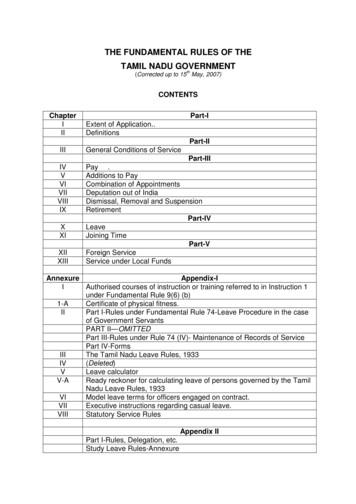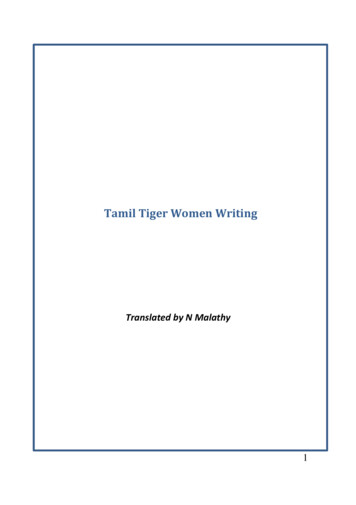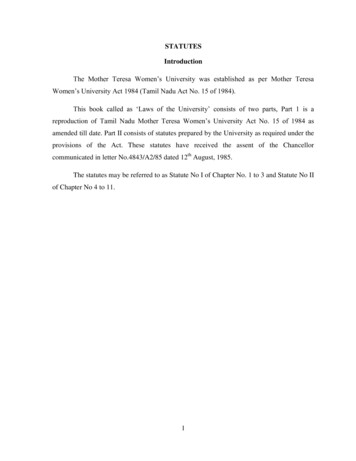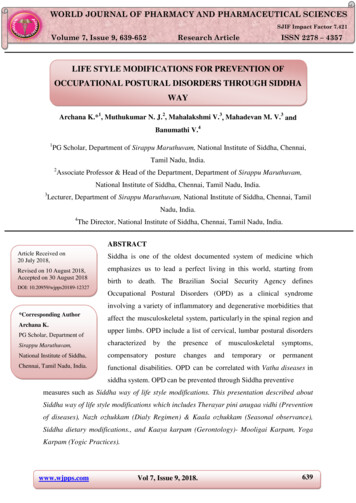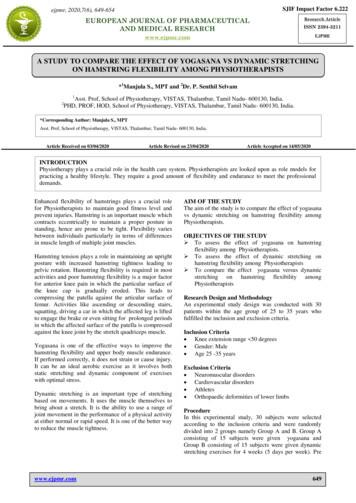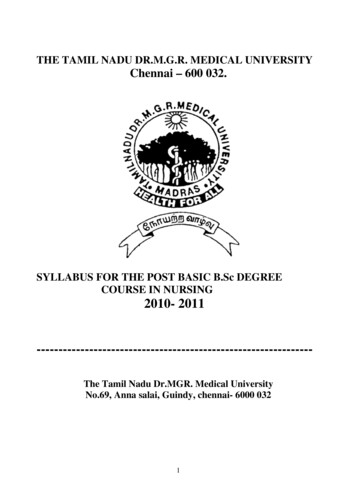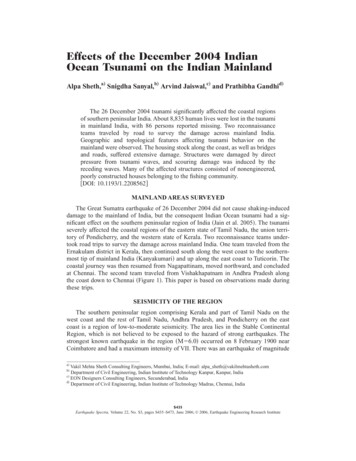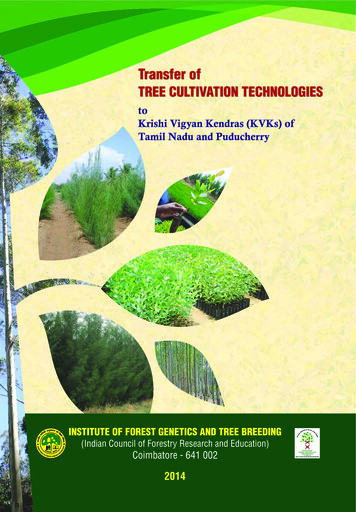
Transcription
Transfer ofTREE CULTIVATION TECHNOLOGIEStoKrishi Vigyan Kendras (KVKs) ofTamil Nadu and PuducherryCompiled byDr. C. BuvaneswaranDr. V. SivakumarMr. R.S. Prasanth, IFSDr. N. Krishna Kumar, IFSINSTITUTE OF FOREST GENETICS AND TREE BREEDING(Indian Council of Forestry Research and Education)Coimbatore - 641 0022014
Published byInstitute of Forest Genetics and Tree BreedingCoimbatore - 641 002.PrintingPrdag PrintCoimbatore - 641 012.Ph : 0422 3059034E-mail : prdagprint@gmail.com
Dr. N. Krishna Kumar, IFSou vkuqoaf'kdh ,oa o {k iztuu laLFkkuDirector andAdditional Principal Chief Conservator of ForestsÒkjrh; okfudh vuqla/kku ,oa f'k{kk ifj"knfi-ch-ua- 1061 dks;EcRrwj 641 002Ministry of Environment and ForestsGovernment of IndiaInstitute of Forest Genetics and Tree BreedingIndian Council of Forestry Research & Education(An ISO 9001:2000 Certified Organisation)P.B. No. 1061, R.S. Puram, HPO., Coimbatore - 641 002, Tamil Nadu, IndiaForewordAgriculture is one of the most important sectors for Indian economyand about 43 % of India's geographical area is used for farming activity butthe share of Indian agriculture in the GDP has steadily declined over theyears and the farming sectors are becoming unviable. There is, therefore,an urgent need to provide package of initiatives for transfer of technology,improving input use efficiency, promoting investments in agriculture andforestry both in private and public sectors and creating a favourable andenabling economic environment. The emerging needs in farming sectorincludes adoption of location specific skill and knowledge basedtechnologies, promotion of greater value addition to agriculture and forestproduce, forge new partnerships between public institutions, technologyusers and the corporate sector, harnessing IT effectively to realizefinancial sustainability and compete in the international market.What is considered necessary today is revival of farming sector andmaking it more economically viable, ecologically sustainable and sociallyacceptable. In addition, assessment and refinement of the technologiesbefore their transfer and a convergent approach involving variousstakeholder institutions and various technology components relevant tothe farmers in varying farming conditions and situations are consideredimportant. The technology assessment and refinement should be based onparticipatory mode to ensure greater linkage between scientists andfarming communities and continuous access to technologies developed bythe research Institutes, academic Institutions and line departments. Forthis Krishi Vigyan Kendras (KVKs) of ICAR, Van Vigyan Kendras(VVKs) of ICFRE, Extension Centres of the State Forest department,
Tree Growers Societies and Farmers Clubs should coordinate and workwith greater focus, attention, determination, commitment and resultoriented for overall rural development through agriculture and forestrysectors. Today Agro-forestry is gaining greater impetus in all programmesof Government.I am sure the Workshop on Tree Cultivation Technologiesorganized by the institute under the Networking of VVKs and KVKs willnot only provide the needed convergent approach for transfer ofappropriate technologies, products and services to the farmingcommunities but will help in understanding the need in each sub sectorswithin farming sector and team building among forestry and agriculturalscientists, extension workers on participatory way.The manual on Tree Cultivation technologies will certainly benefitthe participants and will be useful to the scientists, farming communities,academicians and institutions involved in tree farming.I congratulate and compliment the efforts of Dr. V. Sivakumar,Scientist-E, GTB and the Nodal Officer for VVK and KVK network inTamil Nadu and Shri R.S. Prashanth, IFS, Head, Forest Economics andExtension Division. I wish to thank the Director General, Indian Councilof Forestry Research and Education (ICFRE) for the support andencouragement. I wish to thank Deputy Director General (Research),Deputy Director General (Admn.) and particularly Deputy DirectorGeneral (Extn.), ICFRE for their support. We are extremely thankful tothe Director General, Indian Council of Agriculture Research, Director(Extension Education), Tamil Nadu Agriculture University, Extensionwing of Tamil Nadu Forest Department and scientists of all Krishi VigyanKendras in Tamil Nadu and Pondicherry for the conduct of the workshop.I also extend my thanks to the GCR, scientists and staff associated with theVVK and KVK network and demo village for organizing the workshopand bringing out this useful reading material.Dr. N. Krishna KumarDirector
ContentSl. No. TitlePage No.1.Cultivation Techniques for TEAKK. Palanisamy12.Cultivation Techniques for CasuarinaA. Nicodemus63.Cultivation Techniques for EucalyptusV. Sivakumar124.Cultivation Techniques for Melia dubiaRekha R. Warrier165.Cultivation Techniques for AilanthusD. Rajasugunasekar196.Cultivation Techniques for Gmelina arboreaA. Mayavel, J. Soosai Raj, B. Gurudev Sighand N. Krishnakumar237.Cultivation Techniques for Neolamarckia cadambaA. Vijayaraghavan288.Cultivation Techniques Calophyllum inophyllumR. Anandalakshmi339.Application of N-fixer (an aqua product harbouringsuperior strains of Frankia) as plant growthpromoter for CasuarinasA. Karrthikeyan3610.“Hy-Act”- Biopesticide (seed oil based formulationdeveloped from Hydnocarpus pentandra)S. Murugesan, N. Senthilkumar, D. Suresh Babuand C. Rajeshkannan37
11.Growth promoting product - “Tree Rich Biobooster” 39(An alternate media for potting mixture)S. Murugesan, N. Senthilkumar, N. Krishna Kumar,R. Lakshmi Devi, K. Ramesh, P. Manivachakam,C. Rajeshkannan and D. Suresh Babu12.Biopesticide - “Tree PAL H”41S. Murugesan, N. Senthilkumar, D. Suresh Babu andC. Rajesh Kannan13.Windbreak Agroforestry systems with superiorclones of Casuarina junghuhnianaC. Buvaneswaran, A. Nicodemus, R. Velumani,C. V. Vijayam, K. Vinothkumar andN. Krishna Kumar4314.Bio-Inoculants for Native Tree Species in NurseryV. Mohan4515.Casuarina based ‘Alley cropping’ system for highereconomic returnsS. Saravanan4716.Initiatives of Conservation and Commercializationof Rare Tamarind Genetic ResourcesA. Mayavel, J. Soosairaj B. Gurudev Singh andN. Krishnakumar4917.Tree Pest ManagementJohn Prasanth Jacob5118.Clonal propagation of EucalyptusV.K.W Bachpai6019.Clonal propagation of CasuarinaV.K.W Bachpai63
1Cultivation Techniques for TEAKK. PalanisamyScientistInstitute of Forest Genetics and Tree Breeding, CoimbatoreE-mail : palanisamy@icfre.orgSite factorsTeak grows well in alluvial soils, fairly moist, warm, tropical climatewith pH ranges from 6.5 to 7.5. Teak showed poor growth and form ondry sandy soil, shallow or hard pan soil, acidic, laterite, black cotton andwaterlogged soils. It is a light demanding species relatively high lightintensity, i.e. between 75 and 100% of sunlight for better growth anddevelopment. It occurs from sea level to an altitude of about 1200 m with800-2500 mm rainfall regime and also grows in very moist areas with theannual rainfall of over 3,500 mm. Teak also grows in dry areas of TamilNadu, Rajasthan, Madhya Pradesh, Andhra Pradesh and Maharashtra.In the Indian Peninsula, teak experiences maximum temperatures up to48oC and minimum about 2oC in the dry zone of Central India while inthe moist parts of the Southern India (west coast), the maximum andminimum temperatures of teak distribution ranges from 43oC and 13oCrespectively.Planting stockGenerally stumps or seedlings are used as planting material. For stumppreparation, the seedlings have to be maintained in the nursery for aboutone year. Then the seedlings are uprooted, all the leaves and secondaryroots are removed and stumps (4 to 6 cm shoot with 15 to 20 cm tap rootportion) were prepared. Stump planting is generally preferred and it iseasy for transport. For seedling plantation, young seedlings are shifted to1
polythene bags containing soil mixture and maintained in the nursery for3 to 6 monthsSeed collection, processing and Nursery techniquesGenerally teak starts flowering 6 years after planting, but profuseflowering occurs after 15 years. Flowering occurs from June to Septemberand fruits can be collected from November to January. Though teakproduces profuse flowering the fruit set was very poor (1 to 2%), probablythe coincidence south west monsoon with flowering which affectspollination. The fruits are yellowish and brownish in colour and the numberof fruits varies from 1150 to 2800 per kg. A 40 year old tree produces anaverage about 3 kg fruits. Teak fruit contains 4 seeds, but mostly filled with1 or 2 seeds only. After collection, the fruits are cleaned and then sun driedfor 2-3 days and stored in bags. Teak seeds can be stored for up to twoyears around 12% moisture content in airtight containers.Germination of teak is often poor due to dormancy. Pre treatment ofthe seeds by alternate wetting and drying of the seed for a week is requiredto break the dormancy before sowing. The seeds were kept in a gunny bagand dock the bag in water, preferably in a running stream, for 12 hours,then spread the seed in the sunlight to dry for 12 hours. This has to berepeated for one week. Further grading of fruits according to size help inimproving germination. Germination increases with increase in size offruits.The germination percentage varies from 30 to 50 % in moist teakand 5 to 10 % in dry teak. The seeds were sown in the raised nursery beds(10 x 1 x 0.3 m) prepared with soil and sand mixture. The nursery bedshave to be watered regularly and covered with coconut leaf or paddy straw.Germination starts 10 to 15 days after sowing and continues up to 35 to 45days. The paddy straw may be removed once the seed started germinating.The seedlings can be transplanted to polythene bags or it can be maintainedin the nursery beds for 10 to 12 months for preparation of stumps.2
Plantation managementA suitable land with good soil and rain fall of 1200 mm may beselected for raising teak plantation. The land should be ploughedthoroughly and prepare pits ( 45 x 45 x 45 cm) in 2 x 2 m or 3 x 3 m or 3x 4 m spacing before rainy season. Farm yard manure with soil mixturehas to be prepared and filled in the pits. Seedlings are planted in the pitsduring rainy season. For stump planting crowbar may be used and pittingis not required. In the initial stage the plants have to be watered weekly,and regular weeding and pruning have to be done. The branches have tobe removed periodically without affecting the main stem. Drip irrigationis beneficial in farm lands. Irrigation reduce the rotation period and alsoenhance the productivity. Application of 50 g of urea and 30 g of superphosphate after six months and 75 g of urea and 60 g of super phosphateafter 24 months of planting increases the growth rates. The fertilizers areeffective for enhancement of growth in young teak trees than mature trees.Thinning (removing alternate rows) is done 5 years and 10 years afterplanting in plantation raised with closer spacing (2 x 2m). Mechanicalthinning is also needed. The interval of thinning cycle is at age of 5, 10,15, 20 and 30 for 60 year rotation, in Kerala. Teak can also be planted inbunds in south and north direction in such way the agricultural crops getsufficient light. It was found that there was no significant variation in woodproperties of young (25 to 30 years old) and mature teak (50 to 60 yearsold). Therefore teak plantation raised with good quality planting materialor clones in good soil with limited irrigation and dry period withsilivicultural practices can be harvested within 20 to 25 years. In Braziland Malaysia teak is harvested at the age of 15 to 20 years. The teak growingin the canal areas in Thanjavur and Tiruvarur (Tamil Nadu) showed fastgrowth with good girth ( 150 cm)within 20 years and canal teak isharvested at the age of 30 years.Agroforestry practicesTeak is one of the favoured silvicultural species by the farmers. It isplanted in different models, combinations as well as in different spacements.3
IFGTB has developed agroforestry models like, Agri-silvicultural models(Teak casuarinas with agricultural crops maize, cotton, turmeric, tomatoand chilly), Agri-silvi-horticulture model (Teak coconut with agriculturalcrops plantain, turmeric, vegetables, maize and cotton) and Silvihorticulture model (Teak-Gauva, Annona) (George, 2000). Under irrigatedlands, silvipasture model was developed with Teak and Casuarina as treecomponent and Napier and Guinea as pasture components.YieldThe average productivity of teak in Nilambur teak plantations was2.85 m3 ha-1year-1 in 53 years rotation period. In Indonesia the MAI at theharvest age (40 to 90 years) was 2.91 m3ha -1year -1(FAO, 1986). Theproductivity in moist semi deciduous forest in Ghana was 8-10 m3ha 1year -1(Oteng-Amoako andSarfo, 2005)while in Central America it was 8to 12 m3 ha -1year -1 (Arias, 2005). Recent studies conducted on teak growingin farmlands with irrigation, fertilizer application and managementrevealed the possibility of reducing the rotation period to 25 years withincrease in productivity. The trees grow in farm lands grow faster andproduce more biomass when compared to plantations in the forest areas.The quality of teak timber in farm land at 12 years was found to be similarto that of 20 years in forest land.Important insect pest and diseasesTeak defoliator, Hyblaea puera and leaf skeletonizer, Eutectonamachaeralis are considered to be the major pests in teak. These insects areknown to occur on seedlings in nurseries and also in grown up trees inplantations. H. puera feeds on tender foliages during the early part of thegrowth season and E. machaeralis feeds on older foliage towards the end ofthe season. Making regular pest surveillance in nurseries and youngplantations, particularly during rainy season when there is a new flushformation to detect the occurrence of the pest and removal and destruction4
of larvae if the population is less. If the pest attack is severe it can becontrolled by spraying of the foliage with the chemicals likemonocrotophos or endosulfan 0.05-0.075% or neem based formulations(Neem azal 1%) at 10-12 days intervals can give good control. A virus(NPV) based formulation (biocide) is also available for management ofthe defoliator H. puera.UsesIt has been extensively used for decking, deck houses, rails, bulwarks,hatches, weather doors and planking. The traders and timber usersrecognized several varieties of teak suitable for different end uses. Thehuge teak trees from Western Ghats region (high rain fall range) are usedfor structural needs like ship and boat building, construction and bridgebuilding. Teak from Central Indian region is known for colour, textureand grains preferred for furniture and aesthetic needs. Teak wood ofGodavari valley in Andhra Pradesh is used for furniture and cabinet makingfor its ornamental figuring. Teak wood markets and depots are availablein all teak growing states in India.5
2Cultivation Techniques for CasuarinaA. NicodemusScientistInstitute of Forest Genetics and Tree Breeding, CoimbatoreE-mail : nico@icfre.orgIntroductionCasuarinas are a versatile group of plants with wide-rangingadaptability to grow in different environments and provide multiple enduses and services. They fix atmospheric nitrogen through a symbioticassociation with the bacteria, Frankia. Casuarina wood with a highcalorific value is a renowned fuel wood in the tropics. In India Casuarinaequisetifolia was introduced during the 19th century and is now estimatedto be under cultivation in around half a million hectares mainly in thePeninsular region. Apart from fuel, the wood is extensively used forpapermaking and of late is a preferred choice for biomass-based powergeneration. The straight cylindrical stems find use in rural house buildingand as scaffolds in construction sites. It is the principal species fordeveloping shelterbelts in coastal areas and windbreaks for protectingagricultural crops. It also plays a key role in reclaiming mined areas andafforesting nutrient-poor sites.NurseryCasuarina seeds are small consisting 5 to 6 lakh seeds per kg. Butabout half of them may actually be immature seeds which usually do notgerminate. Germination is generally around 30% and about 30,000 to100,000 seedlings are obtained from a kg of seed depending upon sourceof seed and nursery efficiency. Seeds are sown in raised sand beds (called‘mother beds’) of the size 10 x 1 m. Generally no pretreatment is necessary6
for casuarina seeds. In each bed about 250 g of seeds (50 g for Casuarinajunghuhniana) are evenly spread by mixing with fine sand. They are overlaidwith a thin layer of sand. The sand bed is covered with rice straw to preventwashing off of seedlings while watering. Water is provided through a rosecan or a sprayer. A suitable repellent is applied along the periphery of thebed to prevent ants removing the seeds.Germination and transplantingSeeds start germinating from the 5th day and the straw is removed onthe 7th day. They are grown in the mother beds for the next 3 to 4 weeks.After 4 weeks when the seedlings attain 8 – 10 cm height they are transferredeither to a secondary bed or polythene bags. Secondary beds are also ofthe same size as the mother beds but in addition to sand, farm manure andsoil (2:1:1) are also added to increase nutrient availability and water holdingcapacity. Seedlings pricked from the primary beds are transplanted in thesecondary bed at approximately 4 cm apart. Seedlings are grown in thesecondary beds for 3 months to obtain a height of 30 to 45 cm and a collardiameter of 3 to 5 mm. Growing seedlings in polybags and root trainersis better than bare root seedlings especially for planting in rainfed areas.Seedlings raised in containers establish well in plantations and recordvigorous growth in the first year. Polybags (size: 15 x 7 cm) filled with apotting mixture of sand, farm manure and soil in a ratio of 2:1:1 are suitablefor raising casuarina seedlings. Seedlings may attain plantable size within2 months but can be maintained for another 4 to 6 months if planting isdelayed.Vegetative propagationOutstanding casuarina trees can be propagated by rooting of youngshoots (‘sprigs’). Such plants produce uniform superior growth inplantations. Sprigs collelcted from selected trees are trimmed to 8-10 cmlong and washed in a 5% solution of fungicide like BavistinTM. The lower7
portion of the shoot is treated with a rooting hormone, Indole butyric acid(commercial name: Seradix BTM). The treated cuttings are placed in roottrainers containing vermiculite or treated coir pith and kept in mist chamberor propagation chambers made of polythene sheets. Rooting occurs in 15to 20 days and then transplanted into polybags or root trainers and grownin the same way as seedlings.Inoculation of FrankiaCasuarina is a nitrogen-fixing tree through symbiotic relationship withan actinomycete called Frankia. It fixes atmospheric nitrogen in specialstructures in the roots called nodules. It is necessary to ensure infection ofFrankia in casuarina seedlings for vigorous growth as well as to increasetheir adaptability to planting conditions. Frankia can easily be inoculatedby adding topsoil from casuarina plantations to the mother beds.Alternatively it can be inoculated at the time of transplanting into secondarybeds or containers by treating the seedlings with nodule extract of Frankiaculture (N-fixer) supplied by IFGTB. Application of biofertilizers likephosphobacterium and Glomus fasciculatum also improve the seedlingquality.Planting and Tending MethodsSince casuarina is planted as bare-root seedlings, planting them justbefore or during the rains ensures high survival especially under rainfedconditions. Where irrigation is available, it is recommended to plant onemonth before the rain and provide water once or twice a week. This willhelp the plants to establish well before the arrival of monsoon and growfaster than those planted during the rain.Land must be preferably disc ploughed twice. Pit size for plantingcontainer-raised plants (poly bag or root trainer) is 30 cm x 30 cm x 30 cm.The recommended spacing for realizing full potential of geneticallyimproved planting stock is 1.5 x 1.5 m. Add a basal dose of 10 g of super8
phosphate per pit before field planting of seedlings. Application of antitermite solution (e.g. chlorophyriphos 1ml per litre of water) may be neededin red soils or where the problem has been encountered before. This maynot be necessary in sandy soils in coastal areas. If no rain receivedimmediately after field planting of seedlings, watering in alternate days isnecessary for the first two weeks. The frequency may be reduced graduallyto once or twice a week depending upon local conditions. Casualtyreplacement should be taken up only up to one month after planting. Fourweedings needs to be carried out at 3, 6, 9 and 12 months or till the canopycloses whichever is later. Two prunings need to be taken up at 12 and 24months. Fertilizer application is not necessary after planting if the land isfairly fertile. In low-nutrient soils DAP 100 kg per acre may be appliedbetween 12 and 24 months.Fertilizer ApplicationFertilizer application is generally restricted to irrigated plantationsand varies between regions and even among farmers. Fertilizers will havethe maximum effect if applied during the peak growing period of 12 to 24months. Farmers generally apply 50 kg of urea and 50 to 100 kg of DAPper acre one year after planting. Casuarina does not need large quantityof nitrogen fertilizer since it produces its own nitrogen with the help ofthe bacterium, Frankia. So it is recommended to apply 11 kg of urea and94 kg of super phosphate at four stages: immediately after establishment,6, 12 and 18 months after planting.Pruning and intercroppingPruning of side branches is usually carried out between first and secondyears and second and third years. The expenditure for pruning is met bythe sale of pruned material. It is also a common practice to intercropgroundnut, water melon or pulse crops in the first year well before the treecrown starts closing in and cause shade effect to agriculture crop. The9
plantation establishment cost is generally recovered from the agriculturecrop. It also helps to keep the field weed-free.Insect and disease incidenceCasuarina has only a few major insect and disease incidence whichcan lead to economic loss. The common insect problem in casuarinaplantation is attack by the stem borer, Indarbela quadrinotata. The larvaedig up deep tunnels on the main stem and remain inside the tunnel duringday time and emerge out in night and feed on the bark. Although the treesgenerally survive, the pole quality is affected by severe infection. Affectedtrees are also prone to breaking at the point of infestation during heavywind. Chemical control of this insect is difficult since it resides within thetunnel. Insect attack can be prevented by planting varieties that areunaffected by the insect (e.g. Australia and Kenya).Wilt or blister bark disease caused by Trichosporium vesciculosum resultsin drying up of trees followed by large scale death. Affected trees showsymptoms of drying of leaves followed by ‘blisters” on the main stem. Atadvanced stages these blisters burst open releasing black spores. The diseaseis not considered as a serious problem in plantations because it usuallyoccurs in plantations older than 4 years age. There is no effective controlmeasure once the infection occurred but removing and burning the infectedtree can prevent further spreading of the disease. Australian, Kenyan andMalaysian provenances were found to be resistant to blister bark disease.The C. junghuhniana provenances from East Timor are also not affected bythe disease.Rotation Period and YieldThe commonly followed rotation period is 4 years with irrigation and6 years under rainfed conditions. But the duration varies greatly in differentareas and between farmers. In a few places of coastal Tamil Nadu irrigatedcasuarina is harvested as early as 2.5 years of age whereas Forest10
Department plantations without irrigation are retained up to 8 years. Woodproduction varies greatly across locations, cultivation techniques adoptedand age at which harvested. Plantations with irrigation and fertilizerapplication yield 100 to 150 tonnes of air dried wood (up to 20 cm girth)per hectare (40 to 60 tonnes per acre) in 4 years. Under rainfed conditionsan average yield of 75 to 100 tonnes per hectare is obtained in 6 years (30to 40 tonnes per acre) depending upon soil quality and amount of rainfallduring the cultivation period. IFGTB supplies high quality seeds fromseed orchards which can improve yield up to 25% and the superior clones(IFGTB CE 1, CE2, CE3, CE4, CJ9 and CJ10) produce up to 50% moreyield.11
3Cultivation Techniques for EucalyptusV. SivakumarScientistInstitute of Forest Genetics and Tree Breeding, CoimbatoreE-mail : sivav@icfre.orgSite factorsEucalyptus camaldulensis is a common and widespread tree species. Itis a best suitable tree species for the areas which received rainfall from 250to 600 mm at the same time it can also grow well in high rainfall areaswhich receives as high as 1250 mm. The success of Eucalyptus is attributedto its superiority to other trees in production of wood on infertile dry sites,its tolerance of extreme drought and high temperature. This species occurson a variety of soil types from red or black soils to sandy alluvial soils. Itcan also grow well in salt affected areas.Planting stockSeeds of IFGTB show about 15% improvement in growth whencompare to other local seed sources as the seeds. Seeds are being collectedfrom seed orchards established by IFGTB and sold to the farmers at thecost of Rs. 10000/- per kilo gram.IFGTB has released four Eucalyptus clonal varieties viz., IFGTBEC1, IFGTB-EC2, IFGTB-EC3 and IFGTB-EC4 for cultivation in TamilNadu and Andhra Pradesh. These clones are multiplied and supplied basedon prior request. About 20% improvement in yield is expected from theseclonal varieties.Seed collection, processing and Nursery techniquesSeed are mixed with chaff and can be difficult to distinguish fromchaff. Seeds weigh approximately 700 seeds/gram (Ralph, 2003). About12
100 -500 germinant can come per gram of seed. The seeds with about 5%moisture content can be stored for more than 10 years if they are placed inhermetic containers at a temperature of 3 to 5 C.The texture of the medium of germination must be fine. A fertilemixture of soils with sand in a proportion of 1:1 must be used. Seed shouldbe sown under shade on a free-draining and sterilized medium and coveredvery sparingly with inert material (e.g. sand). Seeds must be sowed deepenough to prevent uncovering when watered, but they must not be tooembedded. The germination period for this method ranges from 4 to 5days. The seedlings are lifted from the mother bed when they are 5 to 7 cmin height and transplanted in poly bags. Alternatively, seeds can also beplanted directly into bags using special devices, such as syringes, to placetwo to four seeds in each bag.Partial shade is needed after transplanting till six weeks. Plants reachplantable size of 30 cm in four to five months. Seedlings require periodicwatering in the first stages of development. Common mistakes inpropagation are over-watering and associated disease problems, overshading and allowing the germinants to become too large for easytransplanting leading to malformed tap roots or root curling in the pots.To prevent damping off, cupric fungicides should be applied. About 1-2lakhs seedlings can be obtained from 1 kg of seed in nurseries.Plantation managementWeeding and burning of underbrush are recommended beforeplanting. The ability of the species to compete with weeds is poor. In highrainfall areas, extensive weeding (2-3 times) must be applied until crownsclose (2-3 years). Inadequate weed control may lead to complete failure ofthe planting.A spacing of 3 m x 2 m (1667 stems/ha) is often applied for pulpwood.Wider spacing of 4 m and 2 m (1250 stems/ha) or 5 m x 2 m (1000 stems/13
ha) are recommended when larger trees are required. For energyplantations, a spacing of 2x2 m is recommended.Application of 100g of NP or NPK (3:2:1) fertilizer to each tree atplanting to assist establishment of growth is common. Crown die-backduring dry-season as a result of boron deficiency is prevalent in few places.A dosage of 10-20 g of borax per tree depending on soil type is applied.In India, Eucalyptus is managed through clear-felling system followedby coppice rotation to a maximum of three times. After three rotations,the below ground biomass is taken out and replanted with seedlings.Forpulpwood depending on the fertility and availability of water, the rotationcan fixed from 5 year to 7 years.Agroforestry practicesAt a spacing of 3 x 2 m intercropping can be carried out for one year. Inirrigated sites, shade loving crops can be cultivated during second yearalso. A wide range of crops can be grown when the spacing is 5 m x 2 mwhich supports intercropping up to three years.YieldIn Tamil Nadu, about 25-30 t/ha at a rotation of 6-7 years was realizedthrough seed raised plantations during early 1990’s. Introduction of clonesincreased the yield up to 60-70 t/ha in six years rotation. Through siteclone matching, a yield of 100-150 t/ha was achieved in five years rotationdepending on the fertility level of the soil.Important insect pest and diseasesIn the nursery, it is susceptible to diverse fungi causing damping-off,collar rot and leaf diseases. Attention to nursery hygiene and care not toover-water are preferable to chemical controls. Termites affect plantedseedlings young trees and must be chemically controlled. Eucalyptus is14
severely attacked by an invasive gall insect (Leptocybe invasa) which
in the canal areas in Thanjavur and Tiruvarur (Tamil Nadu) showed fast growth with good girth ( 150 cm)within 20 years and canal teak is harvested at the age of 30 years. Agroforestry practices Teak is one of the favoured silvicultural species by the farmers. It is planted in dif ferent mode

